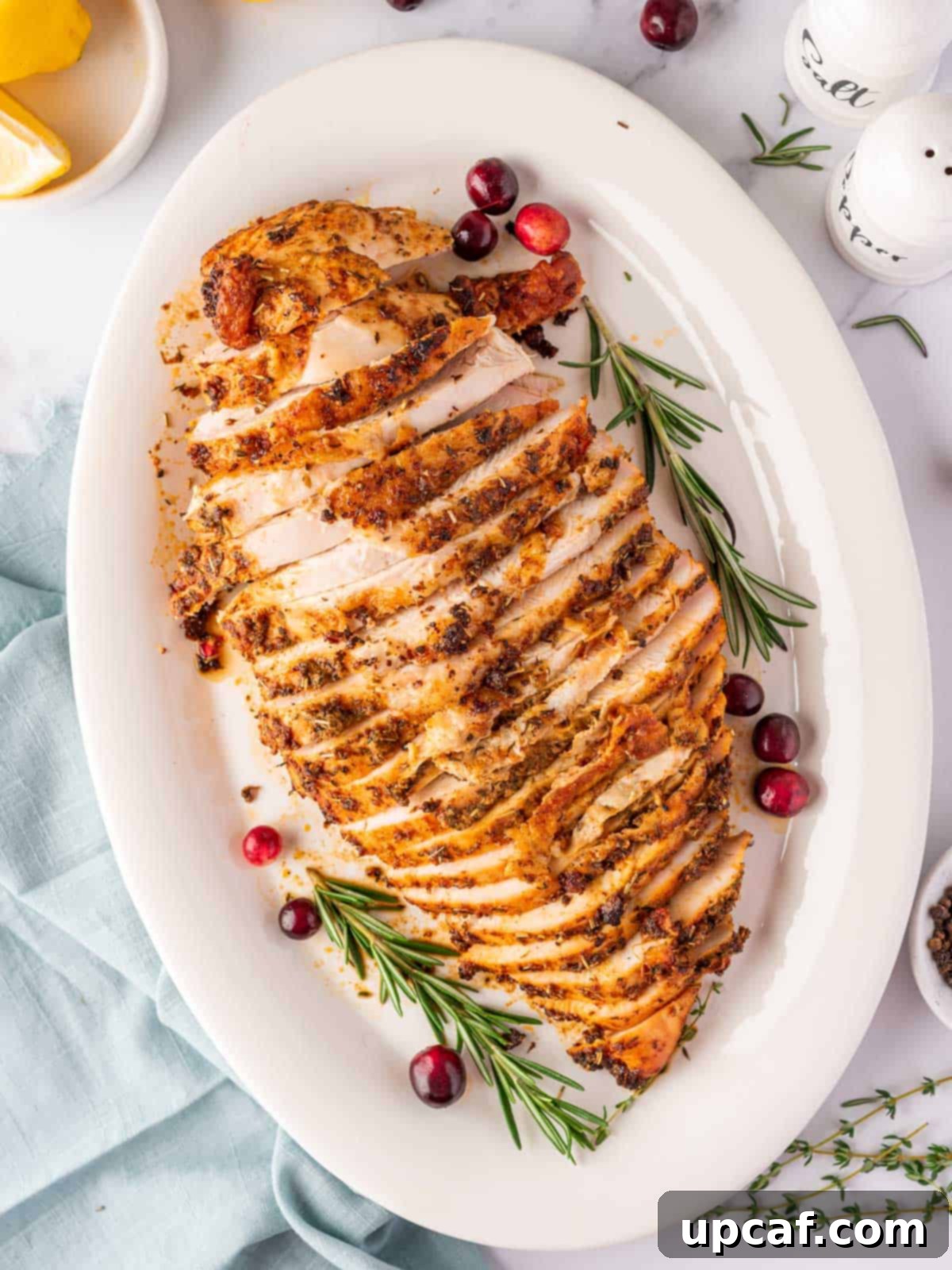Unlock the secret to a perfectly tender, incredibly juicy, and wonderfully crispy roasted turkey breast with this foolproof recipe. Ideal for intimate holiday gatherings, a cozy weekend dinner, or whenever a craving for delicious turkey strikes, this dish simplifies the traditional turkey experience without sacrificing an ounce of flavor or festive appeal. Forget the stress of roasting a whole bird; this boneless turkey breast recipe promises golden-brown perfection with minimal effort, ensuring rave reviews every time.
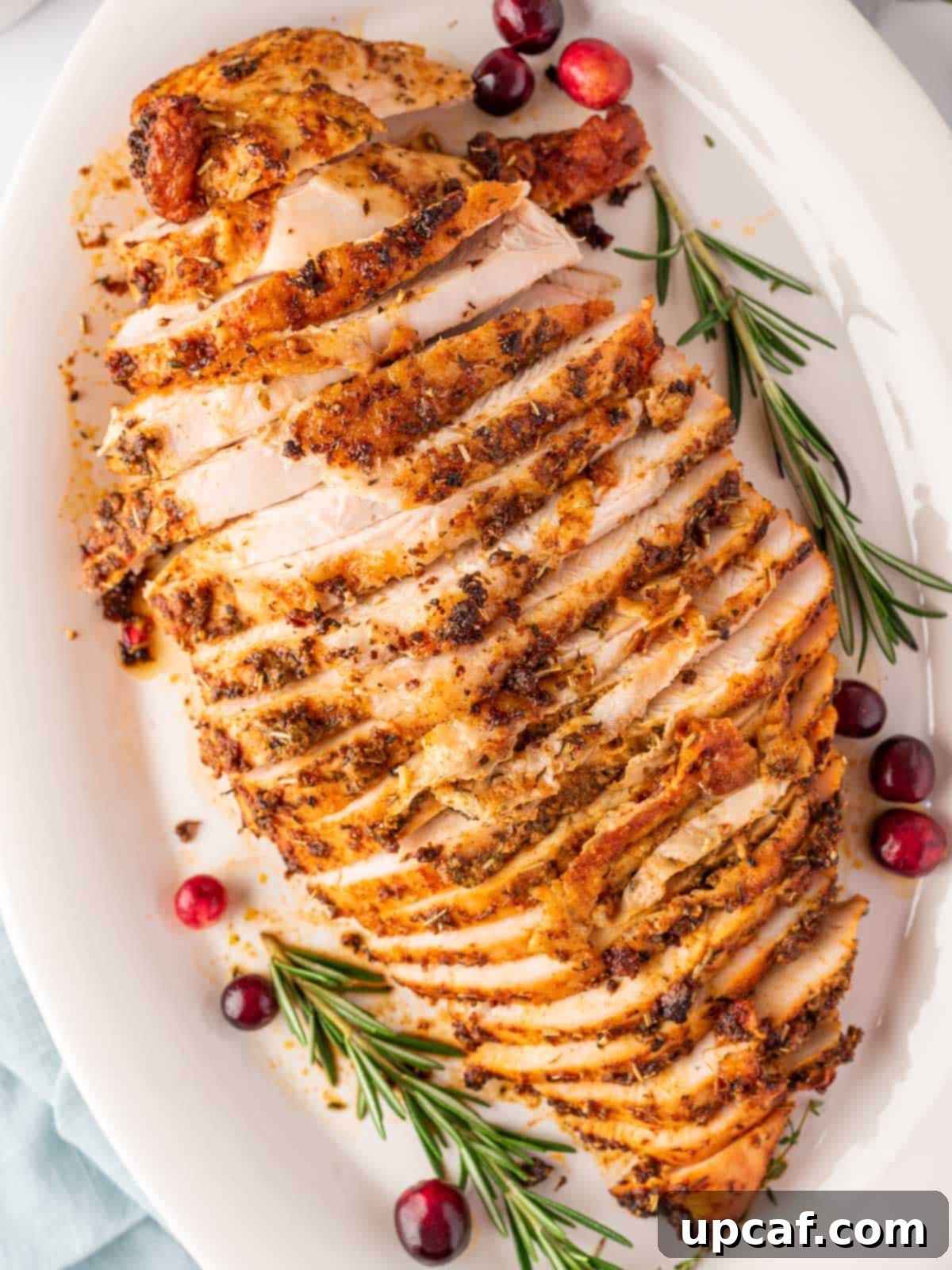
Whether you’re planning an intimate Thanksgiving feast, a delightful Christmas dinner, or simply wish to enjoy the comforting taste of turkey any time of year, this roasted boneless turkey breast recipe is your ultimate guide. It delivers all the satisfaction of a traditional roast with significantly less work, making it a fantastic alternative to cooking a whole turkey. With its irresistibly crispy skin and succulent, moist meat, your guests will undoubtedly ask for second helpings. This recipe ensures a consistently delicious result, making it a staple for your culinary repertoire.
To complement this holiday showstopper, consider pairing it with classic side dishes that elevate the meal. Try my Roasted Garlic Mashed Potatoes for a creamy, flavorful accompaniment, a vibrant Homemade Cranberry Sauce to add a touch of sweet and tart, and an Easy Green Bean Casserole for a timeless favorite. These sides will create a perfectly balanced and unforgettable dining experience.
Why You’ll Adore This Oven Roasted Turkey Breast Recipe
There are numerous compelling reasons why this particular roasted turkey breast recipe will become a cherished favorite in your kitchen:
- Effortless & Time-Saving: Roasting a boneless turkey breast is considerably simpler and quicker than preparing a whole turkey. This means less time in the kitchen and more time enjoying with loved ones. You can even roast multiple turkey breasts simultaneously to feed a larger crowd without the hassle of a massive bird. Plus, carving is a breeze—simply slice and serve!
- Guaranteed Juiciness Every Time: One common challenge with whole turkeys is the risk of overcooking the breast meat while waiting for the dark meat to reach its ideal temperature. By focusing solely on the turkey breast, you eliminate this risk. This recipe ensures your roasted turkey breast remains perfectly cooked, exceptionally tender, and unbelievably moist from edge to center, delivering consistent results every single time.
- Perfect for Year-Round Turkey Cravings: Unlike whole turkeys, which are often seasonal, turkey breasts are readily available in grocery stores throughout the year. This allows you to indulge your turkey cravings anytime, whether it’s for a special occasion in the summer or a comforting meal on a chilly spring evening. Enjoy the rich, satisfying flavor of turkey whenever the mood strikes, without the hunt for a whole bird.
- Ideal for Smaller Gatherings & Weeknight Dinners: This recipe scales beautifully, making it perfect for smaller family meals or intimate gatherings where a whole turkey would be far too much. It also transforms an ordinary weeknight into a special occasion with minimal fuss.
- Flavor Absorption: With a boneless breast, the seasoning can penetrate deeply into the meat, ensuring every bite is infused with delicious flavor. The skin provides a protective layer and crisps up beautifully, adding texture and taste.
Essential Ingredients for a Perfectly Roasted Turkey Breast
Crafting the perfect roasted turkey breast begins with selecting quality ingredients that work in harmony to create a symphony of flavors. Here’s a closer look at what you’ll need and why each component is crucial:
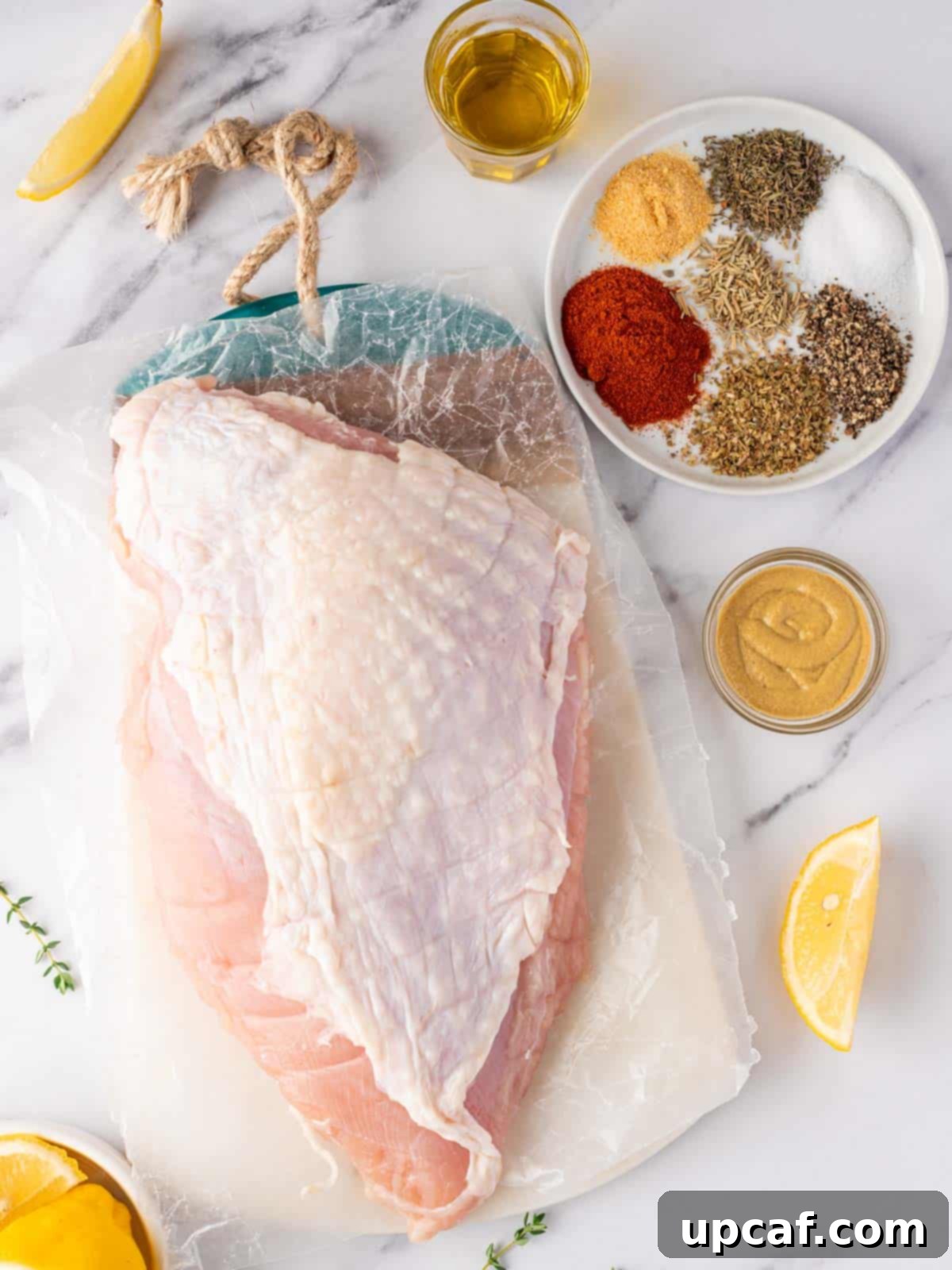
- Olive Oil: Acts as a binder for the seasonings, helping them adhere to the turkey skin. It also aids in achieving that desirable golden-brown, crispy skin. You can substitute with any neutral-flavored oil like avocado oil or grapeseed oil if preferred.
- Fresh Lemon Juice: This brightens the flavor profile and helps tenderize the meat slightly. Always opt for fresh lemon juice for the best, most vibrant taste; bottled juice simply doesn’t compare.
- Dijon Mustard: Adds a subtle tang and depth of flavor, contributing to a savory crust. If you don’t have Dijon, a good quality yellow mustard can work as a substitute in a pinch, though the flavor will be slightly milder.
- The Signature Seasoning Blend: This carefully crafted mix is the heart of our recipe, infusing the turkey with aromatic and savory notes.
- Paprika: Provides a lovely color and a mild, sweet peppery flavor.
- Dried Oregano: Offers earthy, slightly bitter notes that complement poultry beautifully.
- Salt & Black Pepper: Fundamental for enhancing all other flavors and ensuring the meat is seasoned throughout.
- Garlic Powder: Delivers a concentrated garlic flavor that permeates the turkey.
- Dried Thyme: Adds a fragrant, herbaceous essence that is classic with turkey.
- Dried Rosemary: Infuses the roast with a piney, woody aroma that pairs perfectly with the festive feel of turkey.
- Turkey Breast (Skin-On, Boneless): The star of the dish. Choosing a skin-on breast is crucial. The skin renders beautifully in the oven, becoming incredibly crispy and flavorful, while also protecting the delicate breast meat from drying out, sealing in moisture and juices. A boneless breast makes carving exceptionally easy.
- Fresh Herbs (for garnish): A sprig of fresh rosemary, thyme, or parsley adds a beautiful visual appeal and a fresh aromatic touch when serving.
- Fresh Cranberries (for garnish): Scattered cranberries add a festive pop of color and a tart counterpoint to the rich turkey, enhancing the presentation.
- Pomegranate Arils (optional garnish): For an extra touch of elegance and a burst of sweet-tart flavor, pomegranate seeds make a stunning garnish.
How to Make Perfect Boneless Turkey Breast in the Oven
Follow these detailed steps to achieve a perfectly roasted, flavorful, and moist boneless turkey breast that will impress everyone at your table:
- Step 1: Prepare Your Equipment and Preheat the Oven. Begin by preheating your oven to 375°F (190°C). This ensures the oven is at the correct temperature for even cooking from the start. Line a sturdy baking tray with aluminum foil for easy cleanup. If you have one, place a wire rack inside the foil-lined tray. Roasting the turkey on a rack allows air to circulate around all sides, promoting even cooking and helping the skin crisp up beautifully.
- Step 2: Create the Aromatic Spice Mixture. In a medium-sized bowl, combine the olive oil, fresh lemon juice, and Dijon mustard. Then, add all the dry seasonings: paprika, dried oregano, salt, black pepper, garlic powder, dried thyme, and dried rosemary. Stir vigorously until all ingredients are thoroughly combined and form a thick, aromatic paste. This paste is key to coating the turkey evenly and infusing it with deep flavor.
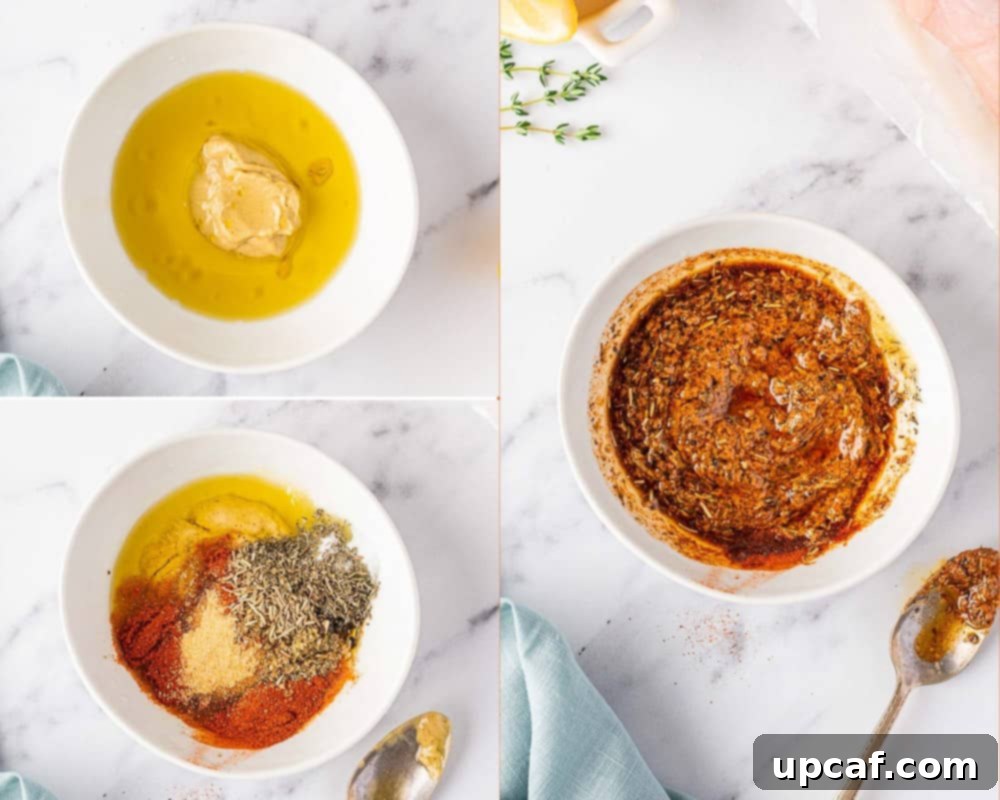
- Step 3: Season the Turkey Breast Thoroughly. Pat the turkey breast completely dry with paper towels. This crucial step helps achieve crispy skin. Gently loosen the skin from the breast meat without detaching it completely, creating a pocket. Spread about half of the prepared spice mixture directly onto the meat under the skin. This ensures the flavor penetrates beyond the surface. Then, generously rub the remaining spice mixture all over the exterior of the turkey breast, including the sides, ensuring it’s evenly coated.

- Step 4: Roast to Golden Perfection. Place the seasoned turkey breast, skin-side up, on the prepared baking tray (preferably on a wire rack). Transfer it to the preheated oven and roast for approximately 1 hour, or until the internal temperature of the thickest part of the breast reaches 160°F (71°C) when checked with a reliable meat thermometer. Cooking times can vary based on your oven and the exact size of your turkey breast, so always rely on the thermometer for accuracy.
- Step 5: Rest, Slice, and Serve. Once the turkey breast reaches the target internal temperature, carefully remove it from the oven. Tent it loosely with aluminum foil and let it rest on a cutting board for at least 10 minutes (15-20 minutes is even better). Resting is vital as it allows the juices to redistribute throughout the meat, ensuring a tender and moist result when sliced. After resting, slice the turkey against the grain into desired portions and serve immediately, garnished with fresh herbs, cranberries, or pomegranate arils if using.
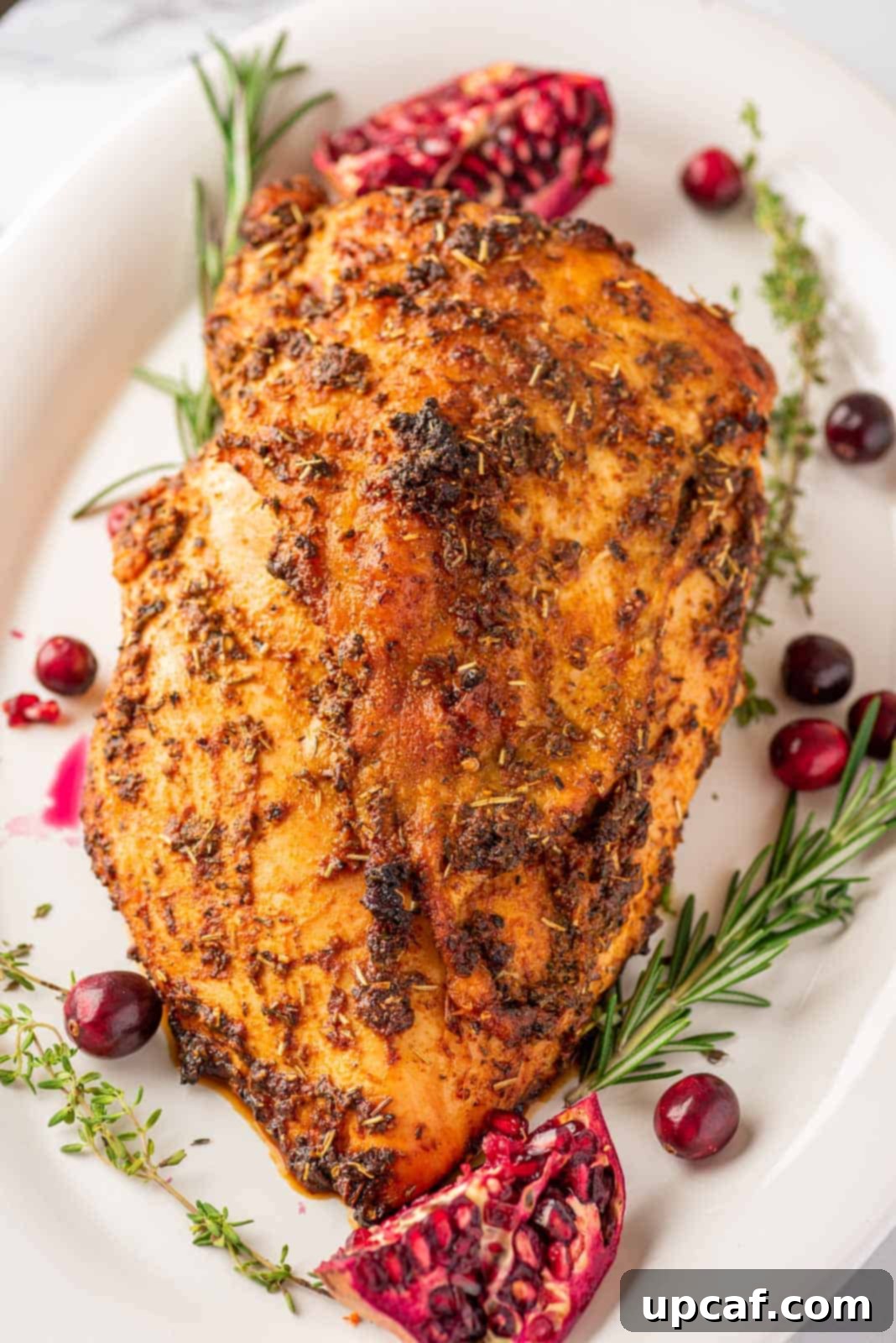
Expert Tips for the Best Roasted Turkey Breast Ever
Achieving a truly outstanding roasted turkey breast involves a few key techniques. Follow these expert tips to ensure your turkey is perfectly cooked, wonderfully moist, and incredibly flavorful:
- Always Trust Your Thermometer: The most crucial tool for perfectly cooked poultry is a meat thermometer. Cooking times are merely guidelines. The internal temperature of your turkey breast should reach 160°F (71°C) when inserted into the thickest part, avoiding the bone if present. The temperature will continue to rise a few degrees during resting (carryover cooking) to reach a safe 165°F (74°C). This prevents both undercooking and overcooking, guaranteeing juiciness.
- Prevent Over-Browning: If you notice the turkey skin browning too quickly before the internal temperature is reached, don’t fret. Simply tent the turkey loosely with aluminum foil. This acts as a shield, protecting the skin from burning while allowing the meat to continue cooking thoroughly.
- Pat Dry for Crispy Skin: This step cannot be emphasized enough. Excess moisture on the turkey skin will steam rather than crisp. Before applying any seasoning, thoroughly pat the entire turkey breast dry with paper towels. A dry surface is essential for achieving that coveted, irresistibly crispy skin.
- The Importance of Resting: Once your turkey breast is out of the oven, resist the urge to slice it immediately. Cover it loosely with foil and let it rest for at least 10-15 minutes (20 minutes for larger breasts). During this crucial resting period, the muscle fibers relax, allowing the internal juices, which have been driven to the center during cooking, to redistribute throughout the entire breast. If you cut into it too soon, those precious juices will simply run out onto your cutting board, leaving you with dry meat.
- Thaw Completely: Ensure your turkey breast is fully thawed before you begin the cooking process. Attempting to cook a partially or fully frozen turkey breast will result in uneven cooking and a dry interior, as the outside will cook much faster than the still-frozen core. Allow ample time for thawing in the refrigerator—typically 24 hours for every 4-5 pounds of turkey.
- Brining for Ultimate Moisture (Optional but Recommended): For an extra layer of moisture and flavor, consider brining your turkey breast overnight. A simple brine solution of water, salt, sugar, and aromatics can dramatically improve the turkey’s juiciness, especially for leaner cuts like the breast.
- Consider a Roasting Rack: Cooking your turkey breast on a wire rack set inside a baking pan helps elevate it, allowing for better air circulation around the entire surface. This promotes more even cooking and contributes significantly to achieving a uniformly crispy skin.
- Basting is Debatable: While some cooks swear by basting, it’s not always necessary for a smaller turkey breast and can even hinder crispy skin by repeatedly cooling the surface. If you do baste, do it sparingly and quickly to minimize heat loss from the oven. The seasoning paste often provides enough moisture and flavor.
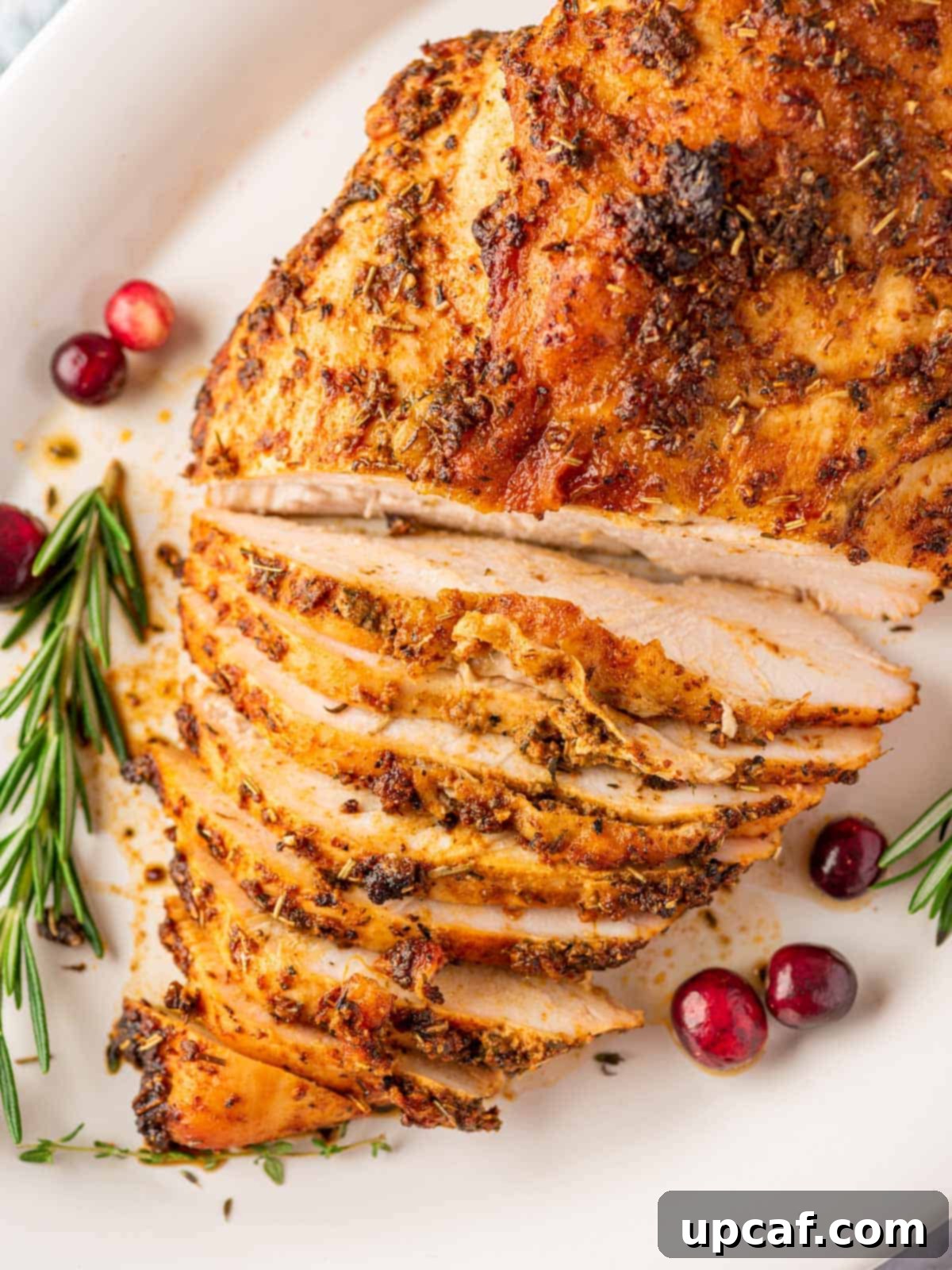
Frequently Asked Questions About Roasting Turkey Breast
Generally, I recommend planning for about one pound of uncooked turkey per person. This usually provides a generous serving. However, if you are hoping for delicious leftovers, or if you know your guests have hearty appetites and will want second servings, it’s safer to aim for 1½ to 2 pounds of uncooked turkey per person. This ensures everyone gets their fill and you have some extra for sandwiches or other creative leftover dishes.
To maintain freshness and moisture, leftover roasted turkey can be stored in an airtight container in the refrigerator for up to 3 to 4 days. For optimal moisture retention, it’s best to store the turkey breast as a whole piece, or in larger chunks, rather than already sliced. When reheating, you can gently warm slices in the oven (covered with foil to prevent drying) to keep the skin slightly crispy, or quickly microwave smaller portions for convenience. Adding a splash of chicken broth or gravy can also help keep it moist during reheating.
It is strongly advised to always allow your turkey breast to thaw completely before cooking. Cooking a turkey breast from frozen or even partially frozen will result in a very unevenly cooked product. The exterior will cook and potentially dry out or burn long before the interior is safely cooked through, leading to an undesirable texture and potentially unsafe food. Plan ahead and thaw your turkey breast thoroughly in the refrigerator for sufficient time—typically 24 hours per 4-5 pounds.
For the majority of the cooking time, I recommend roasting the turkey breast uncovered. This allows the skin to render fat and become beautifully crispy and golden brown, which is a key highlight of this recipe. However, if you notice the skin browning too quickly, especially if your oven has a strong top element or if the turkey is positioned too close to the heat source, you can loosely tent the breast with aluminum foil. This prevents the skin from burning while the interior finishes cooking to perfection. You can also start it on a lower oven rack if browning is a consistent issue.
Several techniques help keep a turkey breast wonderfully moist. Firstly, ensure you’re using a meat thermometer to avoid overcooking; reaching 160°F (71°C) is key. Secondly, consider roasting the turkey breast on a wire rack set over a baking pan containing a small amount of liquid, like water or chicken broth. This creates a steamy environment that helps moisten the air around the turkey. Thirdly, covering the turkey breast loosely with foil towards the end of cooking, especially if it starts to brown too quickly, prevents the outer layers from drying out. Lastly, and perhaps most importantly, allow the turkey to rest, covered, for 10-20 minutes after it comes out of the oven. This crucial step allows the juices to redistribute, ensuring a tender and succulent final result.
The cooking time for a turkey breast can vary significantly based on several factors: the size and weight of the breast, whether it is boneless or bone-in, and the precise temperature of your oven. A typical 2-3 pound boneless turkey breast roasted at 375°F (190°C) usually takes about 1 hour to 1 hour and 15 minutes. Larger breasts will naturally require more time. The most reliable way to determine doneness is by using a meat thermometer to ensure the thickest part of the breast reaches an internal temperature of 160°F (71°C), as it will continue to cook during the resting period.

More Inspiring Holiday & Everyday Dinner Ideas
If you’re searching for more delicious and versatile poultry recipes, especially around the holidays or for a satisfying family dinner, explore these other fantastic options:
- Oven Baked Turkey Breast: Another fantastic method for a juicy turkey breast.
- Stuffed Turkey Rolls: Elegant and flavorful, perfect for a special occasion.
- Oven Roasted Spatchcock Chicken: A quicker way to roast a whole chicken with incredibly crispy skin.
- Oven Baked Roasted Whole Chicken: The classic, comforting roast chicken, elevated.
- Garlic Butter Turkey Meatballs: A delightful and easy alternative for ground turkey.
- Air Fryer Boneless Turkey Breast: For when you want crispy turkey even faster!
- Baked Turkey Drumsticks: Flavorful and fun, a great option for dark meat lovers.
I genuinely hope you find immense joy in all the recipes I share, and this particular Roasted Boneless Turkey Breast recipe is no exception. It’s designed to bring deliciousness and ease to your table. I highly encourage you to give it a try, savor every bite, and share your experience with your friends and family!
If you create this recipe and love it, please consider leaving a star rating and a comment below to let us know how it turned out. Your feedback is invaluable! You can also share your delectable creations with me on INSTAGRAM by using my hashtag. Don’t forget to follow Cookin’ With Mima on FACEBOOK | INSTAGRAM | PINTEREST for all my latest recipes, cooking tips, and social updates. Happy cooking!
Roasted Boneless Turkey Breast Recipe

This Roasted Boneless Turkey Breast recipe is coated in a delicious seasoning blend, then baked to golden brown perfection. The skin is so crispy and the meat is perfectly tender and moist. This is the perfect quick and easy option for a small holiday meal or weekend dinner!
- Author: Mariam Ezzeddine
- Prep Time: 10 minutes
- Cook Time: 1 hour 10 minutes
- Total Time: 1 hour 20 minutes
- Servings: 4 servings
Ingredients
- 2 tablespoons olive oil
- 2 tablespoons lemon juice (freshly squeezed)
- 1 tablespoon Dijon mustard
- 2 teaspoons paprika
- 2 teaspoons dried oregano
- 2 teaspoons salt
- 1 teaspoon black pepper
- 1 teaspoon garlic powder
- 1 teaspoon dried thyme
- 1 teaspoon dried rosemary
- 3 pound turkey breast with skin, boneless
- ½ cup fresh cranberries, to garnish
- 1 pomegranate, quartered (for arils), to serve
- Fresh herbs (such as rosemary or thyme), to garnish
Instructions
- Preheat your oven to 375°F (190°C). Line a sturdy baking tray with aluminum foil for easier cleanup. If you have a wire rack, place it inside the foil-lined tray.
- In a medium bowl, combine the olive oil, lemon juice, Dijon mustard, paprika, oregano, salt, black pepper, garlic powder, thyme, and rosemary. Mix all ingredients thoroughly until they form a smooth paste.
- Ensure the turkey breast is thoroughly patted dry with paper towels. Gently loosen the skin from the breast meat, being careful not to detach it completely. Spread about half of the prepared spice mixture directly onto the meat under the skin. Then, rub the remaining spice mixture evenly all over the exterior of the turkey breast, covering all surfaces.
- Place the seasoned turkey breast, skin-side up, on the prepared baking tray (or wire rack). Cook for approximately 1 hour, or until the internal temperature of the thickest part of the turkey breast reaches 160°F (71°C) when checked with a reliable meat thermometer.
- Once cooked, remove the turkey breast from the oven. Tent it loosely with aluminum foil and allow it to rest for 10 to 15 minutes. This resting period is crucial for the juices to redistribute, ensuring a moist and tender result. After resting, slice the turkey breast against the grain and serve immediately, garnished with fresh cranberries, pomegranate arils, and fresh herbs.
Notes
- Cooking times are approximate; always rely on a meat thermometer to ensure the turkey reaches 160°F (71°C) internally.
- If the turkey skin browns too quickly, loosely cover it with aluminum foil to prevent burning.
- Patting the turkey breast dry before seasoning is essential for achieving crispy skin.
- Allow the turkey to rest after cooking for at least 10 minutes to redistribute juices and ensure tender, moist meat.
- Always thaw frozen turkey breast completely in the refrigerator before cooking to ensure even cooking and prevent dryness.
Nutrition (per serving)
- Calories: 420kcal
- Carbohydrates: 3g
- Protein: 74g
- Fat: 13g
- Saturated Fat: 2g
- Polyunsaturated Fat: 2g
- Monounsaturated Fat: 7g
- Trans Fat: 1g
- Cholesterol: 184mg
- Sodium: 1908mg
- Potassium: 890mg
- Fiber: 1g
- Sugar: 1g
- Vitamin A: 594IU
- Vitamin C: 3mg
- Calcium: 77mg
- Iron: 3mg
